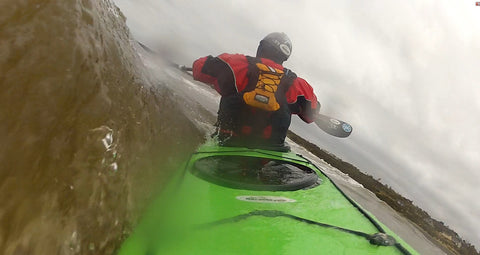Kayak Control
How do we effectively control these things we call kayaks? It's in the use of your body, your boat and your blade!
There are two types of stability inherent in kayaks: Initial Stability and Secondary stability learning to use both to our advantage will mean more control and a better experience in our kayaks.
Initial Stability:
A post on Wikipedia explains it like this: "
Initial stability is the resistance of a boat to small changes in the difference between the vertical forces applied on its two sides. It is determined by the angle of tilting on each side of the boat as its center of gravity (CG) moves sideways as a result of the passengers or cargo moving laterally, or as a response to an external force (e.g. wave).

The wider the boat and the further its volume is distributed away from its center line (CL), the greater the initial stability." This sums it up fairly well. Wide flat bottom kayaks will have a ton of initial stability....in flat water...why would I mention that? Well here's the thing, a wide kayak that is hard to capsize also tends to be hard to edge (see the picture for secondary stability) edging is one of the primary ways we control our boat. If you cant edge your boat then it is doing more of the control over you than you are over it! A kayak with a ton of initial stability is going to be hard to edge but will give you tons of confidence if you are just starting out.
The other type of stability that kayaks have is secondary stability. Secondary stability is simply how resistant is the kayak to small changes in the difference between the vertical forces applied on its sides when the kayak is up on edge.

As shown in the picture above, I am able to keep my kayak upright in larger waves because I am able to edge the kayak towards the wave. I essentially adjust my (and my kayaks) center of gravity into the wave. This allow the kayak to resist a rotational moment and instead transfers the waves kinetic energy into linear kinetic energy (towards the beach) instead of rotational kinetic energy (me upside-down).
I cant do this in a wide kayak (it's designed to resist rotating remember?) so why wouldn't the wider kayak be a better selection for this type of thing? It's simple the wide (typically) recreational kayak is designed to stay on the water and not rotate. When the water, however, becomes an angle greater than what your body and kayak's combined center of gravity can handle (remember it will be very hard to adjust that in a wide kayak) then the angle of the wave will result in the kayak capsizing.This is only one of many benefits to having a narrower kayak with more secondary stability. Another benefit is the ability to use the secondary stability and edging to turn.
Edging to turn is best combined with a powerful sweep stroke and pushing the foot on the footpeg on the outside of the kayak. By that I mean if I'm going to turn to the right I will edge my kayak away (to the left)(by cocking the right side of my hip up, taking pressure off my right butt cheek, and lifting my right knee in my thighbrace), I will also push hard on my left foot brace and then I will combine a strong sweeping stroke into the equation (again on my left side). In high angle style paddling we bring the paddle down to a low angle (your upper hand will stay at about nipple level) which brings the paddle blade further away from the kayak increasing the moment arm and thus increasing torque on the kayak.
CLICK HERE FOR A VIDEO IN WHICH I USE EDGING TO TURN SHARPLY AROUND ROCKS
Resources:
https://en.wikipedia.org/wiki/Initial_stability
